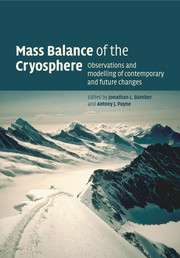Book contents
- Frontmatter
- Contents
- List of contributors
- Foreword
- Preface
- 1 Introduction and background
- Part I Observational techniques and methods
- Part II Modelling techniques and methods
- Part III The mass balance of sea ice
- Part IV The mass balance of the ice sheets
- Part V The mass balance of ice caps and glaciers
- Index
Foreword
Published online by Cambridge University Press: 16 October 2009
- Frontmatter
- Contents
- List of contributors
- Foreword
- Preface
- 1 Introduction and background
- Part I Observational techniques and methods
- Part II Modelling techniques and methods
- Part III The mass balance of sea ice
- Part IV The mass balance of the ice sheets
- Part V The mass balance of ice caps and glaciers
- Index
Summary
The regions of the great ice caps in the Arctic and Antarctic are places of stunning beauty. Also, being tantalizingly remote and largely unspoilt by human interference, they hold compelling fascination and interest. However, these are not the only reasons for their study. Compared with the rest of the Earth's surface, they are of importance far beyond what might be expected from their comparative size. The changing balance in the cryosphere between the accumulation and ablation of ice has dominated the Earth's climatic history through the quasi-regular ice ages of the last million years – extending also to earlier epochs about which rather less is known. The world's coastal regions have been enormously affected as this changing balance has led to large excursions of sea level. For instance, at the end of the last ice age, 20 000 years or more ago, the sea level was lower than today by about 120 metres.
The long-term driving influence on the mass of ice in the polar regions, either in the form of sea ice or locked in the ice caps, has been the regular oscillations in key features of the Earth's orbit around the Sun, namely its eccentricity, the tilt of the Earth's axis and the time of year when the Earth is closest to the Sun. These features change with periods varying from about 20 000 years to about 100 000 years, and combine to cause substantial variations in the amount of solar energy that reaches the polar regions at different times of year, most particularly in the northern summer.
- Type
- Chapter
- Information
- Mass Balance of the CryosphereObservations and Modelling of Contemporary and Future Changes, pp. xv - xviPublisher: Cambridge University PressPrint publication year: 2004

